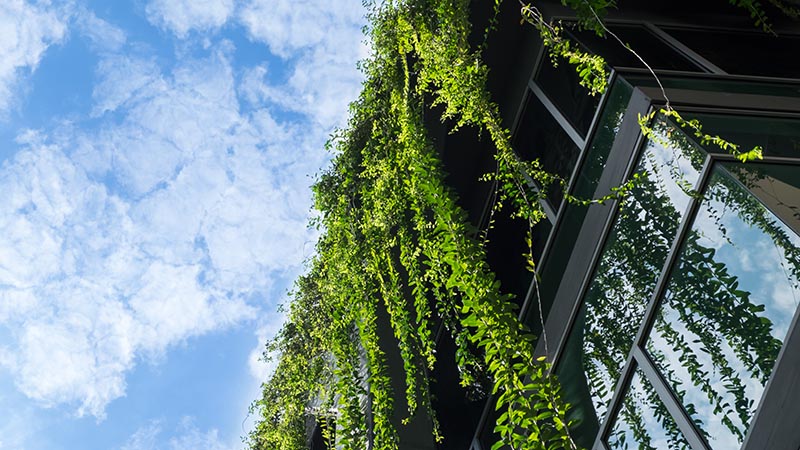Construction codes not enough when it comes climate-friendly homes
Homeowners in Australia are increasingly taking matters into their own hands when it comes future proofing their family homes and reducing their impact on the environment.
Homeowners in Australia are increasingly taking matters into their own hands when it comes to future proofing their family homes and reducing their impact on the environment.
With climate change impacts on the rise, new and existing homes will need to be durable and resilient to withstand extreme weather events like floods, bushfires and increasing temperatures.
The Australian government lags behind other countries, like those in Europe, when it comes to climate change action and regulations around environmental design features for new homes.
Industry experts are urging investors, homeowners and aspiring homeowners to future proof their property against climate risks and think beyond the initial cost of doing so.
Construction code not enough
When it comes to houses, homeowners and investors need to worry about what they can’t see.
In Australia, builders are required to adhere to the National Construction Code for the technical design and construction of new homes.
The code sets out the minimum requirements for areas such as safety and health but does not take into consideration the durability of the house being built.
Jorge Chapa, Head of Market Transformation at Green Building Council of Australia, expressed his concerns relating to the code.
“There are only limited requirements for climate change in the existing planning or construction codes,” he said.
“For instance, there is no current requirement for light-coloured roof materials, and design features to withstand weather conditions are based on historic wind speeds or temperatures.”
“Future weather in Australia is expected to be hotter, and light-coloured roofs help cool a home.”
Builders, homeowners go it alone
Morgan Koegal, Senior Campaigner at the Climate Council, said more than ever before Australian homes are being built with residents’ climate concerns in mind.
“Many of Australia’s largest home builders have committed to building all-electric homes without gas, a dangerous and polluting fossil fuel,” she said.
“On top of that, just over 17 per cent of homes are being built to energy efficiency standards beyond the minimum set by the government, meaning the home needs less energy to run and produces fewer emissions.”
“Whole communities, like Ginninderry in the ACT and The Cape in south eastern Victoria are being built to higher standards with rooftop solar and batteries to save people megabucks on their bills and to make a meaningful contribution to reducing emissions.”
“Research has shown that homes with higher energy efficiency attract a price premium, with buyers recognising they will save more money on energy bills in the long run.”
Not only are homebuilders doing their part to future proof the housing market, so are aspiring homeowners.
“People are looking to live more sustainably and recognise that the materials that go into their home and the energy they use to power it can be major sources of emissions,” Ms Koegal said.
“Many homebuilders have reported a surge of customers wanting to build with sustainability in mind.”
“One of the biggest shifts has been growing recognition that appliances that use gas (for cooking, heating and hot water) are adding to the problem of climate change, as well as impacting negatively on the health of people in the home.”
“Luckily, there are efficient electric alternatives to all gas appliances, and more people are seeking to purchase or build a home without gas, and even retrofit existing properties to remove gas appliances altogether.”
On the flipside, Cecille Weldon, Director of WeldonCo Advisory, said the industry has been slow to respond.
“The residential real estate and volume housing industries have been slow to respond to the opportunities afforded by better homes that are more responsive to seasonal climate changes and cheaper to run, specifically the role that effective marketing can play at point of sale or rent,” the real estate industry sustainability advisor said.
“This is especially the case when it comes to identifying and marketing the property features that matter for climate readiness and lifestyle benefits correctly at point of sale or rent.”
A similar sentiment was shared by Simon Cookes, a registered architect and the founder and CEO of LARKI, an online design technology platform.
“Australian houses are decades behind places like northern Europe where Passive Haus type insulated property with thermally exchanged fresh air changes are the norm, not the exception like in Australia,” he said.
“We have a long way to go and there is a lot of opportunity for our new federal government.”
Thinking long-term
Mr Koegal at the Climate Council said investors need to think long-term when building a home, keeping in mind that it could be standing for the next 50-70 years.
“Getting things right at the time of building, like the orientation of the home, properly sealing gaps and not connecting to the gas network means big savings each year, and a house that is better prepared for events like heatwaves and blackouts.”
“Upgrading a house later on is much more costly, so it makes sense to build an all-electric energy efficient home from the start.”
Mickael Roger, Co-Founder and Co-CEO at PropHero, said investors needed to do their research when considering purchasing a property to mitigate the changes of buying in an area that could down the track be uninsurable or vulnerable.
“As heatwaves, droughts, fires and floods become more frequent and extreme, real estate investors need to take climate threats into account when purchasing a new property.”
“A big question is whether the past is a reliable predictor of the future.
“Those once in 100 year events could now be one in 10 year events – and that changes everything.”
“While some regions and suburbs are likely to become riskier, others within relatively safe zones could soon attract a premium and provide an opportunity for property investors."
“Our team at PropHero works with insurance and data providers to perform extensive mapping of areas most at risk from adverse weather events and we’ve made it a priority to include several climate-related variables in the mix of factors we apply to select the best properties.”
"Traditionally, investors could look to insurance as an answer to the problem.
“However, in vulnerable areas of Australia, premiums are now eye-wateringly high and in the future, more areas are going to be uninsurable.
“The best insurance is to avoid the wrong properties."
Discounted home loans for properties that meet exacting environmental standards have been offered by six smaller lenders for a year or two, and Commonwealth Bank has also recently moved into the green loan space.
Expert tips for homeowners and investors
1. Study location and surrounding environment
Ms Weldon said it’s critical aspiring home buyers understand the climate zone.
“This will tell you the seasonal climate changes you will encounter to ensure you have the right heating and cooling mix to provide comfort all year round without huge running cost bills,” she said.
“When buying, building, or renovating a home, it is important to consider the current and predicted future climate of your region.”
Mr Cookes agreed.
“Get an affordable, quick and convenient 3D laser scanned land survey to understand your surrounding environment in detail, such as the actual trees, rocks, and natural terrain, for more precise environmental simulations like shadow studies, light irradiation for solar, and natural ventilation inputs.”
2. Paying more upfront to ensure climate-readiness
Ms Weldon said potential home buyers and investors need to consider the long-term game of their new home, rather than just the cost to buy in today’s market.
“It’s about climate-readiness risk and whether the property will maintain its value, adapt to the climate well, and be cheaper to run, with the potential for comfort all year round,” she said.
“These are the properties that are worth paying more for, as they will maintain their value in the property market and respond to the needs of the today’s more informed property consumer.
3. Maximise your energy efficiency
Mr Cookes said getting an energy rating assessment done and designing to maximise the rating will save homeowners money on their bills.
Ms Weldon encouraged those building a home to go beyond the six star energy ratings.
“Research shows that between 7 and 8 stars is the sweet spot.”
Mr Chapa also weighed in saying that Green Star homes will also have utility bills that are approximately 75 per cent lower.
























